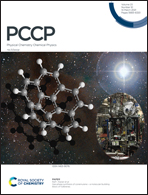Multilevel oxygen-vacancy conductive filaments in β-Ga2O3 based resistive random access memory†
Abstract
β-Ga2O3 has recently attracted considerable attention for its application in resistive switching memory. However, the resistive behaviors and mechanisms of β-Ga2O3 memory dominated by the oxygen-vacancy (VO) still remain controversial. In this study, we systemically investigated the formation process of VO conductive filaments in β-Ga2O3 memory. There were at least three kinds of VOs and conductive filaments with different low resistance states (LRSs) in β-Ga2O3 memory, suggesting their potential for multilevel storage application. Interestingly, these conductive filaments preferred to be formed along the [010] direction and with a single VO cluster rather than a mixed VO cluster due to the lower single VO cluster formation energy and ellipsoid charge distribution. The lowest migration and activation barriers for different kinds of VOs in +2 charge states (V2+Os) were discrepant and lower than the neutral charge states. Meanwhile, the forward migration energy of VO was different from the reversed migration path, so that the conductive filament formation and rupture were not an inverse process in the experiment. The detailed mechanisms were revealed by the charge density and migration process of these VOs. These results not only revealed the function of the VO conductive filaments in β-Ga2O3 memory but also predicted the potential of β-Ga2O3 memory for multilevel storage application.



 Please wait while we load your content...
Please wait while we load your content...